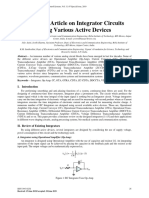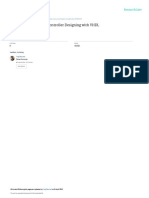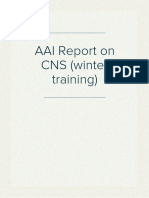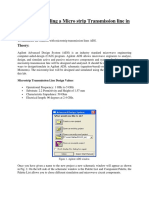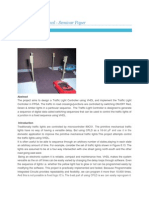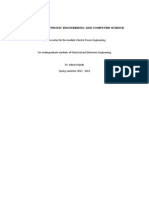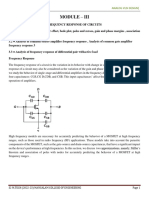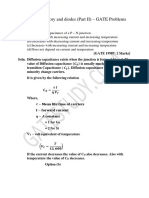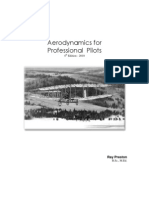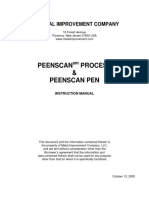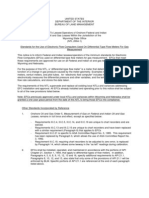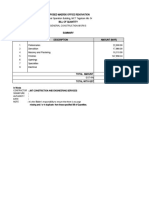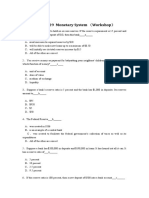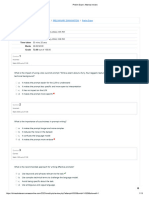Traffic Light Controller System Using Counter
Traffic Light Controller System Using Counter
Uploaded by
isabelCopyright:
Available Formats
Traffic Light Controller System Using Counter
Traffic Light Controller System Using Counter
Uploaded by
isabelCopyright
Available Formats
Share this document
Did you find this document useful?
Is this content inappropriate?
Copyright:
Available Formats
Traffic Light Controller System Using Counter
Traffic Light Controller System Using Counter
Uploaded by
isabelCopyright:
Available Formats
See discussions, stats, and author profiles for this publication at: https://www.researchgate.
net/publication/348578000
Four-Way Traffic Light Controller System
Article · December 2020
CITATIONS READS
0 11,015
9 authors, including:
Md. Ether Deowan Kazi Shahadat Kabir
American International University-Bangladesh American International University-Bangladesh
3 PUBLICATIONS 0 CITATIONS 6 PUBLICATIONS 0 CITATIONS
SEE PROFILE SEE PROFILE
Nayeem Reza Sopnil Tasdid Hasan
American International University-Bangladesh American International University-Bangladesh
1 PUBLICATION 0 CITATIONS 31 PUBLICATIONS 229 CITATIONS
SEE PROFILE SEE PROFILE
Some of the authors of this publication are also working on these related projects:
Automated Gas Leakage Detection and Safety System View project
Traffic Light Controller System using Counter View project
All content following this page was uploaded by Kazi Shahadat Kabir on 18 January 2021.
The user has requested enhancement of the downloaded file.
Four-Way Traffic Light Controller System
Md Ether Deowan, Kazi Shahadat Kabir, Saidul Arefin Emon, Aman Ullah, Samiul Azim,
Md Nayeem Reza Sopnil, Md. Jobaer Hossain, Tasdid Hasan, Zahid Hasan Khoka
Department of Electric and Electronics Engineering
American International University-Bangladesh
E-mail: Shahadat7034@gmail.com
Abstract−The simple traffic light controller design environmental pollution caused by traffic Most importantly
project was introduced to alleviate this shortcoming and increases road safety. Control down to 4-phases traffic
gain experience in solving implementation and system with the traffic flow optimization strategies are the
interfacing problems of a modern digital system. we main objective of this project.
implement a fully functional traffic signal controller for
II.TRAFFIC-LIGHT CONTROLLER DESIGN
a four-way intersection. The function of a traffic light
controller requires sophisticated control and This project describes a simple traffic light controller
coordination to ensure that traffic moves as smoothly design project for a junior level VLSI class at the Bijoy
and safely as possible. The project was designed in Sarani. It requires to develop a state machine-based
DSCH by using a 4-bit counter. The software controller for traffic signals at a four-way intersection. This
implementation of the circuit was simple and reliable. intersection has two travel lanes in each direction; east,
west, north and south. This project stresses the difference of
Keywords— Counter, alleviate, DSCH, Traffic writing DSCH and Cadence Virtuoso for modelling and
Control, flip-flop, timer, logic control. synthesis and Microwind for creating the schematic layout.
Optimize the traffic flow at network junctions.
I. INTRODUCTION
III. TRAFFIC-SIGNAL PHASE SEQUENCES
Traffic lights, also known as traffic lamps, traffic signals,
stoplight, stop-and-go lights semaphore or robots, are The traffic light controller must handle a four-phase
signalling devices positioned at pedestrian crossings, road signal intersection. If we consider only straight way
intersections, and other locations to control competing flows of direction when Bijoy Sarani street is on then traffic is
traffic. Traffic lights have installed in most cities around the followed by North to South or South to North alternatively.
world to control the flow of traffic. It assigns the right of way During this EW street traffic is stopped by Red signal. After
to road users by the use of lights in standard colours (Red completion of NS street now EW street traffic is followed
- Yellow - Green), using a universal colour code (and a by East to West or West to East alternatively. If we
precise sequence, for colour blind). Traffic lights are used at considered another possibility to follow traffic in another
busy intersections to more evenly apportion delay to the direction rather than straightway direction, we can see from
various users. The increasing amount of traffic in the cities fig.1 that during Bijoy Sarani street on vehicles can go to
has a large impact on the congestion and the time it takes to left or right direction according to North-South direction
reach a certain destination. parallelly to main direction because EW street is OFF
during this. Similarly, we can say about EW street.
A Traffic light controller plays a very important role to control
the vehicles on the busy roads. Nowadays there are occurring
many accidents because of the lack of properly maintained
traffic signals. Besides, it creates a huge traffic jam. For
example, in Dhaka city, the flow of vehicles in most of the
crossways is not properly maintained. As a result, Dhaka city is
badly affected by the traffic jam. This traffic light controller
can be used to solve the traffic problem.
To solve these congestion problems, we have to build new
facilities and infrastructure. The only disadvantage of making
Fig.1: Four Way Road Structure.
new roads on facilities is that it makes the surroundings more
congested. So, for that reason we need to change the system IV. DESIGN IMPLEMENTATION
rather than making new infrastructure twice. The Main goals of
this paper are improving safety, minimizing travel time and This project was implemented in DSCH v3.5
increasing the capacity of Infrastructures. Such improvements simulation software. This project is a combination of a 4-bit
are beneficial to health, economy and the environment. counter using D flip-flop, an inverter, 3 input and gate and
Measurably improve traffic flow. Reduce Light emitting diodes. Design process:
I. A D flip-flop was designed. Then the flip-flop schema If there is low input when the clock pulse is provided the
was converted into a symbol. flip-flop will reset. In this project, D flip-flop has been used
II. Using the 4 D flip-flop symbol a 4-bit counter was for designing the counter circuit.
designed and then converted into a symbol.
III. Finally, the traffic light controller was designed using
the counter, an inverter, and an and gate.
IV. With every count of the counter, the state of the traffic
lights changed.
A traffic light at the intersection of north south (NS) and
east-west (EW streets goes through the following cycles of
states: both red (30 sec), NS green (30 sec), NS yellow (5 s)
-- both red(5s) EW green (30 sec) EW yellow (5sec). A 0.2
Hz clock signal is available for timing. Both streets are
equipped with sensors that detects the presence of a car
close to the intersection. Whenever there is a car close to the
intersection on the street currently having its light red while Fig.4: D flip-flop in DSCH.
there is no car approaching the intersection on the street
with green light, the switchover takes place and green light
immediately turns to yellow.
Fig.5: D flip-flop layout.
Fig. 2: Block diagram.
V. COMPONENT DESCRIPTION
Asynchronous counter: Asynchronous counters are
Logic Gate: An AND gate and an INVERTER is used those whose output is free from the clock signal. Because
for this project. The inverter inverts high input to low output the flip flops in asynchronous counters are supplied with
and low input to high output. Here inverter is also used for different clock signals, there may be a delay in producing
controlling lights. output Asynchronous counter is a type of counter where
clock pulse is provided to the clock input of the first flip-
D flip-flop: The D flip-flop tracks the input, making flop only. The second flip-flop is triggered by the output of
transitions with match those of the input D. In a D flip-flop the first flip-flop, the third flip-flop is triggered by the
there is one input and one clock. If the input is high when output of the second flipflop, and so on.
the clock pulse is applied the flip-flop will set.
Fig.6: 4 Bit Counter in DSCH.
Fig.3: D flip-flop in cadence.
Fig.11: Traffic light controller system circuit layout.
Fig.7: 4 Bit Counter in Cadence. Table Ⅰ: Truth Table
Fig.8: 4 Bit Counter Layout.
VI. WORKING PRINCIPLE
The system consists of an asynchronous counter inside
which there are four D flip- flops. Using the clock pulse and
Reset switches, the traffic lights are controlled. A reset and
a clock are given as input to the counter. With every clock
pulse, the counter counts one bit, and the state of the light
change. While two face to face lights (street 1 & 3) would
be turned green another two would be red and vice versa.
The circuit was designed according to the proper logic
diagram to fulfil this operation. The pulse rate of the clock
can be set according to wish. The complete circuit is shown
VII. RESULT
in the figure below.
After the implementation, we observed every state. Among
them, three observations are shown below.
First observation:
Two opposite signal’s red lights are on (Road 2 and 4) while
the other two signal’s green lights are on (Road 1 and 3).
Fig.9: Traffic light controller in DSCH.
Fig.12: Observation 1 .
Fig.10: Traffic light controller in Cadence .
Second observation:
Now in every road all yellow light will turn on with
previous state. In this way with every count of the counter,
the state of the traffic lights changed.
Fig.16: Timing Diagram of the system.
VIII. ADVANTAGES AND DISADVANTAGES
This design Process may be done in many ways. For
example, by using Arduino, by using 555 timers, counters,
and so on. Here we have used 4-bit asynchronous counter.
Every design has its purpose. Based on that every design
Fig.13: Observation 2.
has some advantages and disadvantages.
Third observation:
The advantages of these projects are, this design process is
In this state of the counter road 1 and 3 will block by
simple and easy to design by using. The hardware
turning on the red led on the other hand the road 2 and 4
implementation will cost low. As we have followed a simple
will free to move the vehicle by turning on the green led.
design process. Easy to find the errors. Traffic control
signals provide for an orderly movement of traffic. There is
less chance of error as the face-to-face traffic lights depend
on the counter.
Disadvantages are, as we have used D flip-flop, a delay flip
flop in this circuit increased the circuit's size. There are
associated with propagation delays. Traffic control signals
may result in a re-entrant collision of vehicles. They may
cause a delay in the quick movement of traffic. Another
main disadvantage is we cannot set the times for signals
individually.
IX. SOCIAL AND ECONOMIC IMPACT
Fig.14: Observation 3. Today's world is almost fully autonomous. For a heavy
traffic city, it is a bad way to control traffic signals manually
According to counter input our design will work and where it can create big problems for a tiny mistake. The
the cycle will be continuing project will work in a fully autonomous process which will
Timing Diagram: reduce the dependency on manual traffic signal changing.
Besides, it will reduce traffic jams and accidents as it will
work in a sequential process. And it is a good solution to
control traffic signals because of its simple design and low-
cost implementation and maintenance.
X. CONCLUSION
We have designed full system of Traffic-Light Controller by
implementing the logic of block diagram of the system and
could simulate the result on LED 7-segment display using
counter and switchover of LED during this counter interval.
Instead of a manual traffic signal, we could go for an
Fig.15: Timing Diagram for counter. autonomous traffic light simulator, where the controller on each
crossway will determine the duration of signal lights for the
traffic of that particular road. The controller, on detecting
the traffic amount will trigger the control and ensure that the
green signal is given for the required duration. A simulation-
based traffic light controller system is good for analysing and
making necessary modifications. Further development would
be done on the traffic control system to become a more
suitable and less costly model.
XI. REFERENCES
[1]. V. Panchal, "Four-Way Traffic Light Controller Designing with
VHDL," Research Gate, 2014. DOI:
10.13140/RG.2.1.4194.7282
[2]. J. E. Ortiz and R. H. Klenke, "Simple traffic light controller: A
digital systems design project," Proceedings of the IEEE
SoutheastCon 2010 (SoutheastCon), Concord, NC, 2010, pp.
85-88, doi: 10.1109/SECON.2010.5453915.
[3]. ELECTRONICS HUB, "Asynchronous Counter," 5 AUGUST
2015. [Online]. Available: https://www.electronicshub.org
/asynchronouscounter/#:~:text=UP%20%2F%20DO WN%
20counter. [Accessed 15 December 2020].
[4]. Neil H. E. Weste and David Money Harris, “CMOS VLSI
Design: A Circuits and Systems Perspective (4th Edition)” Ed.
4th.
View publication stats
You might also like
- EE 215 Lab 3 HandoutDocument5 pagesEE 215 Lab 3 HandoutArnav Mathur100% (1)
- DDEC FOR MBE (MBE 900/4000) Vehicle Interface Harness: Power WiringDocument1 pageDDEC FOR MBE (MBE 900/4000) Vehicle Interface Harness: Power WiringDagar GR75% (4)
- Assignment 2021-22Document2 pagesAssignment 2021-22Dan Ojwang67% (3)
- A Review Article On Integrator Circuits Using Various Active DevicesDocument7 pagesA Review Article On Integrator Circuits Using Various Active DevicesRaja Chandru100% (1)
- Traffic Light Controller Using V HDLDocument10 pagesTraffic Light Controller Using V HDLDedy Slamet RiyadiNo ratings yet
- Traffic Light Controller Using V HDLDocument10 pagesTraffic Light Controller Using V HDLYulia Cyntia DewiNo ratings yet
- Diff BTWN MOSFET and BJTDocument2 pagesDiff BTWN MOSFET and BJTMadan R HonnalagereNo ratings yet
- To Design An Adaptive Channel Equalizer Using MATLABDocument43 pagesTo Design An Adaptive Channel Equalizer Using MATLABAngel Pushpa100% (1)
- AGV Project REPORTDocument20 pagesAGV Project REPORTDARSHAN DayaNo ratings yet
- 6-A Prediction ProblemDocument31 pages6-A Prediction ProblemPrabhjot KhuranaNo ratings yet
- R-22 Eca Lab ManualDocument59 pagesR-22 Eca Lab ManualGovardhan NunetiNo ratings yet
- Exponentially Damped Sinusoidal Signal Simulation in Matlab™Document2 pagesExponentially Damped Sinusoidal Signal Simulation in Matlab™HusnainNo ratings yet
- Digital Control (BER4113)Document18 pagesDigital Control (BER4113)cipet imphal100% (1)
- EXPT 04 - 4-PSK Modulation & DemodulationDocument6 pagesEXPT 04 - 4-PSK Modulation & Demodulationanika tabassumNo ratings yet
- Report On AAI-CNSDocument56 pagesReport On AAI-CNSRahul PhulwariaNo ratings yet
- VHDL Code For Full Subtractor Using Behavioral Method - Full Code & ExplanationDocument8 pagesVHDL Code For Full Subtractor Using Behavioral Method - Full Code & Explanationtojo zoNo ratings yet
- Manual PLC FestoDocument77 pagesManual PLC Festoul15e5100% (1)
- GROUP 4 - OP AMP Integrator - OP AMP DIFFERENTIATOR CIRCUITDocument10 pagesGROUP 4 - OP AMP Integrator - OP AMP DIFFERENTIATOR CIRCUITArt Vincent Subastil - ChoraleNo ratings yet
- Section 12-1 Analog-to-Digital Conversion: SolutionDocument4 pagesSection 12-1 Analog-to-Digital Conversion: SolutionsalmanNo ratings yet
- lm35 Using Atmega8Document13 pageslm35 Using Atmega8Nandan MaheshNo ratings yet
- NAS Lab ManualDocument25 pagesNAS Lab ManualPurvansh Jain100% (1)
- Delta Sigma ModulatorDocument13 pagesDelta Sigma ModulatorSri Hari100% (1)
- BCS Practice Questions - 2021Document11 pagesBCS Practice Questions - 2021bharatshrawagiNo ratings yet
- Lec-2 Image Enhancement in The Frequency DomainDocument74 pagesLec-2 Image Enhancement in The Frequency DomainravibabukancharlaNo ratings yet
- Answer To Microcontroller QPDocument5 pagesAnswer To Microcontroller QPVinod KumarNo ratings yet
- Lab No.2 Modeling A Micro Strip Transmission Line in ADS: Objective: TheoryDocument5 pagesLab No.2 Modeling A Micro Strip Transmission Line in ADS: Objective: Theorymuhammad jehangirNo ratings yet
- Digital Communication Line Codes PDFDocument7 pagesDigital Communication Line Codes PDFAzImmNo ratings yet
- Unit 5 - MTInPDR - Part ADocument51 pagesUnit 5 - MTInPDR - Part AChandrashekher CNo ratings yet
- Block Diagram of 8085Document32 pagesBlock Diagram of 8085Ayush DusejaNo ratings yet
- Optimum Detection of Binary PAM in Noise: PAM: Pulse Amplitude ModulationDocument9 pagesOptimum Detection of Binary PAM in Noise: PAM: Pulse Amplitude ModulationGeorges ChouchaniNo ratings yet
- Formatiin of Y Bus MatrixDocument6 pagesFormatiin of Y Bus MatrixMd Raton AliNo ratings yet
- 4 Way Traffic SignalDocument4 pages4 Way Traffic SignalAnup Singh100% (2)
- ME Week 9 WaveguidesDocument33 pagesME Week 9 WaveguidesSaad NadeemNo ratings yet
- Traffic Light Control SystemDocument21 pagesTraffic Light Control SystemabhisheksingjadonNo ratings yet
- B.tech Matlab Mini Project ListDocument6 pagesB.tech Matlab Mini Project ListRasool ReddyNo ratings yet
- D 01Document209 pagesD 01Raj Boda0% (1)
- Objective: Setup Example 1Document9 pagesObjective: Setup Example 1emailkprajeshNo ratings yet
- Report - Phase ShifterDocument8 pagesReport - Phase ShifterAmeer AliNo ratings yet
- GSM Report FullDocument101 pagesGSM Report FullW.D.P.C PereraNo ratings yet
- UNIT-4 FinalDocument70 pagesUNIT-4 FinalanandbabugopathotiNo ratings yet
- MultiSim PDFDocument5 pagesMultiSim PDFjaya1816No ratings yet
- Sample and Hold AssignmentDocument8 pagesSample and Hold AssignmentRen BurnettNo ratings yet
- Embedded System Lab Manual: B.Tech (Cse) Vi SemesterDocument56 pagesEmbedded System Lab Manual: B.Tech (Cse) Vi Semesterjesudosss0% (1)
- Practical File: Optoelectronics and Optical Communications LabDocument21 pagesPractical File: Optoelectronics and Optical Communications Labyogesh sharmaNo ratings yet
- What Are The Questions Asked by MG Motors in Written Test in Previous YearDocument2 pagesWhat Are The Questions Asked by MG Motors in Written Test in Previous YearSasi KiranNo ratings yet
- Linux Based Speaking Medication Reminder ProjectDocument4 pagesLinux Based Speaking Medication Reminder ProjectEditor IJTSRDNo ratings yet
- Unit 3.1 Miller EffectDocument3 pagesUnit 3.1 Miller EffectchettiyathNo ratings yet
- P N Junction Theory and Diodes Part II - GATE Problems 001Document32 pagesP N Junction Theory and Diodes Part II - GATE Problems 001ayush guptaNo ratings yet
- 3.design in Z Using Root Locus 2016 17Document8 pages3.design in Z Using Root Locus 2016 17kkkprot50% (2)
- Multiplexer & DemultiplexerDocument23 pagesMultiplexer & DemultiplexerVarunNo ratings yet
- Experiment No:-07 DATE:24-09-20 Aim: To Realize Log and Antilog Amplifier Using Op-AmpDocument9 pagesExperiment No:-07 DATE:24-09-20 Aim: To Realize Log and Antilog Amplifier Using Op-AmpJainil ShahNo ratings yet
- AssignmentDocument1 pageAssignmentojwangdan8615No ratings yet
- Or Based Traffic Light Controller Using 8085Document9 pagesOr Based Traffic Light Controller Using 8085praveenrock1118100% (1)
- Ena Lab Manual - SolvedDocument69 pagesEna Lab Manual - SolvedUmair Ejaz Butt100% (1)
- Traffic Light Controller Systemusing CounterDocument6 pagesTraffic Light Controller Systemusing CounterShahab KhanNo ratings yet
- Traffic Light Controller Systemusing CounterDocument6 pagesTraffic Light Controller Systemusing CounterLiên Phan KimNo ratings yet
- Traffic Light Controller System Using CounterDocument6 pagesTraffic Light Controller System Using CounterMighty PubgNo ratings yet
- Traffic Light Controller System Using CounterDocument6 pagesTraffic Light Controller System Using Counterselvazhagan.mech23No ratings yet
- 1st PresentationDocument21 pages1st PresentationAnonymous qh5UUGT80% (5)
- Project Report On Dynamic Traffic SystemDocument46 pagesProject Report On Dynamic Traffic SystemAmit SharmaNo ratings yet
- Handbook on Construction Techniques: A Practical Field Review of Environmental Impacts in Power Transmission/Distribution, Run-of-River Hydropower and Solar Photovoltaic Power Generation ProjectsFrom EverandHandbook on Construction Techniques: A Practical Field Review of Environmental Impacts in Power Transmission/Distribution, Run-of-River Hydropower and Solar Photovoltaic Power Generation ProjectsRating: 2 out of 5 stars2/5 (1)
- AerodynamicsDocument221 pagesAerodynamicskyoobumNo ratings yet
- Saran Offer LetterDocument3 pagesSaran Offer LetterVijay Prabu100% (1)
- Peenscan Pen Instruction ManualDocument13 pagesPeenscan Pen Instruction ManualPanneer SelvamNo ratings yet
- CW 202305 StudentsDocument9 pagesCW 202305 StudentsJIN CHIA LEONGNo ratings yet
- Business Policies & Strategic Management: SR - No Description Option1 Option2 Option3 Option4 ADocument19 pagesBusiness Policies & Strategic Management: SR - No Description Option1 Option2 Option3 Option4 AKrish KrishNo ratings yet
- R. Wed1 Rusmawan KusumahDocument7 pagesR. Wed1 Rusmawan KusumahghinaNo ratings yet
- 1-Morata Vs GoDocument4 pages1-Morata Vs Goeunice demaclidNo ratings yet
- Wyoming Measuring LawsDocument5 pagesWyoming Measuring LawsJohn KayceeNo ratings yet
- A Report On Customer Satisfaction On Technological Services of Private Commercial BanksDocument169 pagesA Report On Customer Satisfaction On Technological Services of Private Commercial BanksdrriyaaNo ratings yet
- ID Pola Pemakaian Kontrasepsi Dan PemanfaatDocument15 pagesID Pola Pemakaian Kontrasepsi Dan PemanfaatRosdianaNo ratings yet
- Maersk - New BOQDocument22 pagesMaersk - New BOQMT JasonNo ratings yet
- Chapter 29 Monetary SystemDocument5 pagesChapter 29 Monetary SystemMunkh-Erdene OtgonboldNo ratings yet
- Tapco 2006Document104 pagesTapco 2006qiritical99No ratings yet
- Infection Prevention and Control Policies and Guidelines For Health Care ServicesDocument324 pagesInfection Prevention and Control Policies and Guidelines For Health Care ServicesAlejandro Caballero ChumillasNo ratings yet
- Rdcucing NPT - Lean Manufacturing AproachDocument9 pagesRdcucing NPT - Lean Manufacturing AproachFerney BohorquezNo ratings yet
- Jurnal AcuanDocument23 pagesJurnal Acuanrosa kristianingrumNo ratings yet
- Hach TKN Method 10242 Final 01102013Document10 pagesHach TKN Method 10242 Final 01102013Oudah AliNo ratings yet
- SE-107700A2 XT1 CB CertificateDocument3 pagesSE-107700A2 XT1 CB CertificatehamzaNo ratings yet
- Krohne Marshall Product OverviewDocument56 pagesKrohne Marshall Product Overviewzakir84md3639No ratings yet
- The Senators' DirectoryDocument32 pagesThe Senators' Directorymonalisailagan.07No ratings yet
- Problems Faced by Small Scale Fishing Community in OdishaDocument10 pagesProblems Faced by Small Scale Fishing Community in OdishaAnonymous CwJeBCAXpNo ratings yet
- 36 50 Ai Prompt Prelim ExamDocument13 pages36 50 Ai Prompt Prelim Examsiegrid mae evardoneNo ratings yet
- 3D Attack - 2005 - 04Document56 pages3D Attack - 2005 - 04varis6No ratings yet
- Send WhatsApp and Email Without VBADocument6 pagesSend WhatsApp and Email Without VBALuis Alberto GNo ratings yet
- PDFDocument28 pagesPDFMiraNo ratings yet
- Portakabin Edition 16 Lesson Resource Ansoffs MatrixDocument2 pagesPortakabin Edition 16 Lesson Resource Ansoffs MatrixAwantha MaharagamaNo ratings yet
- Operating Systems MCQsDocument29 pagesOperating Systems MCQstayyabNo ratings yet
- Ex Parte Hughes and Fletcher: Decided February 9, 1924Document3 pagesEx Parte Hughes and Fletcher: Decided February 9, 1924Sarah BursteinNo ratings yet
- BHCS38896 Panametrics PanaFlow LC Datasheet - R12 1Document8 pagesBHCS38896 Panametrics PanaFlow LC Datasheet - R12 1cinthiacruzNo ratings yet



